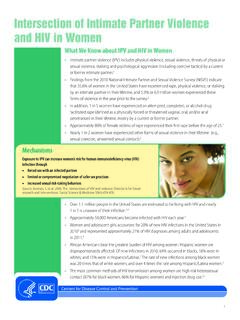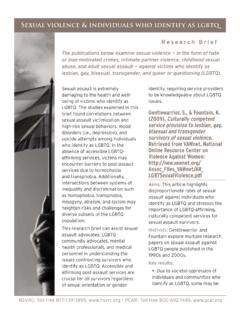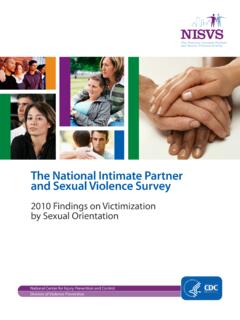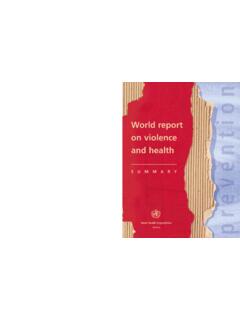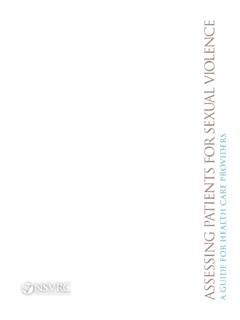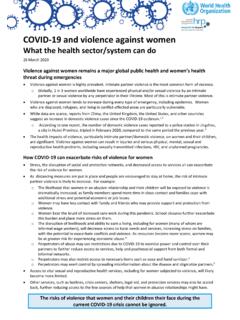Transcription of COMMUNITY DIALOGUES ON GENDER BASED VIOLENCE - …
1 World Education, Inc., Bantwana Initiative, Box 6234, Arusha, Tanzania DIALOGUESON GENDER BASEDVIOLENCE:A FACILITATOR S GUIDEC ommunity DIALOGUES on GENDER - BASED VIOLENCE Facilitator Guide 2 The development of this guide was made possible by the generous support of USAID/PEPFAR. The contents are the responsibility of World Education, Initiative s Pamoja Tuwalee s program and do not necessarily reflect the views of USAID/PEPFAR. Content and materials for this guide have been adapted from the following sources: Project s COMMUNITY Engagement Facilitator sManual draft (2011). Project and Promundo s Engaging Men at theCommunity Level manual (2008). Toolkit for Working with Men and Boys, Family VIOLENCE PreventionFund, San Francisco, CA., Voices/CEDOVIP s SASA! Activist Stones Training Initiative. Protection Ourselves and Each other: A call to Action.
2 (2012) Initiative. Guidance and Tools on Conducting CommunityDialogues for GBV - World Education/Bantwana - Zimbabwe Initiative. Guidance and Tools on Conducting CommunityDialogues for GBV - World Education/Bantwana - Swaziland Prevention Network. COMMUNITY Dialogue Guide: 16 Days of Activism.(2005)For More Information, please visit the World Education, Initiative website: Printed in TanzaniaCommunity DIALOGUES on GENDER - BASED VIOLENCE Facilitator Guide 3 ACKNOWLEDGMENTS World Education developed this COMMUNITY Dialogue on GENDER BASED VIOLENCE Facilitator Guide as a tool for practitioners to use participatory methodologies to facilitate COMMUNITY DIALOGUES on GENDER - BASED VIOLENCE prevention. This guide was developed by compiling a range of existing published materials. World Education gratefully acknowledges the contributions of other organizations whose materials were used to create this guide, notably - Raising Voices, Engender Health, Promundo, and Stepping Stones.
3 Every session in the guide references the original material from which it was sourced or adapted. WEI/Bantwana used the following methodology in compiling this guide: First, World Education conducted an extensive literature review to identify already developed materials and curricula that address GENDER norms. Only materials that were externally evaluated and found to be effective at changing attitudes or reducing intimate partner VIOLENCE or GBV were included. Second, these materials were reviewed and sessions/modules that used participatory methodologies identified by World Education were short-listed. Third, using the selected materials from the short-list, World Education selected relevant sections and modules from the material, adapted them to the Tanzania context as necessary and sequenced them to create a series of 9 dialogue sessions.
4 Fourth, World Education piloted these sessions and made further revisions BASED on the experience of the pilot. World Education, is currently using this tool to address harmful GENDER norms and address intimate partner VIOLENCE in targeted communities in Northern Tanzania under the USAID/PEPFAR funded Pamoja Tuwalee program. WEI/Bantwana would like to thank the consultant Esther Mtuli Majani who compiled this document for WEI/Bantwana. World Education is pleased to share this COMMUNITY DIALOGUES on GENDER BASED VIOLENCE Facilitator Guide with other implementing partners working to address harmful GENDER norms and prevent or reduce intimate partner VIOLENCE in Tanzania. Lilian Badi Chief of Party, Pamoja Tuwalee World Education COMMUNITY DIALOGUES on GENDER - BASED VIOLENCE Facilitator Guide 4 Contents ACKNOWLEDGMENTS 3 LIST OF ABBREVIATIONS 5 I.
5 INTRODUCTION 6 PROGRAM BACKGROUND 6 PURPOSE OF THE GUIDE 6 WHO IS THIS GUIDE FOR? 6 HOW CAN THIS GUIDE BE USED? 7 II. USING COMMUNITY DIALOGUE SESSIONS TO ADDRESS GBV 8 WHAT IS GBV? 8 WHAT IS A COMMUNITY DIALOGUE SESSION? 8 PREPARING FOR COMMUNITY DIALOGUE SESSIONS 9 TIPS FOR FACILITATING COMMUNITY DIALOGUE SESSIONS 11 III. COMMUNITY DIALOGUE ACTIVITY SESSIONS 12 DIALOGUE 1: INEQUITABLE GENDER NORMS RELATED TO GENDER - BASED VIOLENCE (1 HOUR)3 13 DIALOGUE 2: POWER DYNAMICS IN THE COMMUNITY : POWER WALKABOUT (1 HOUR)3 17 DIALOGUE 3: POWER IMBALANCE AND VIOLENCE : NEW PLANET (2 HOURS) 21 DIALOGUE 4: POWER IMBALANCE AND VIOLENCE : ROOT CAUSE AND CONTRIBUTING FACTORS (1 HOUR) 27 DIALOGUE 5: GENDER - BASED VIOLENCE FISHBOWL (1 HOUR) 30 DIALOGUE 6: GENDER - BASED VIOLENCE USING PRINT, AUDIO, AND AUDIOVISUAL MATERIALS (2 3 HOURS) 33 DIALOGUE 7: PROMOTING COMMUNITY MEMBERS TO BECOME ACTIVE BYSTANDERS (1 HOUR)2 38 DIALOGUE 8: CREATING GBV PREVENTION MESSAGES (1 HOUR) 41 DIALOGUE 9: DEVELOPING AN ACTION PLAN TO DISSEMINATE GBV PREVENTION MESSAGES (1 HOUR) 43 IV.
6 APPENDICES: ADDITIONAL FACILITATOR RESOURCES 44 APPENDIX 1: SELECTING THE TARGET GROUP 44 APPENDIX 2: PERSONAL DAY-TO-DAY REFERENCE OF KEY POINTS 45 APPENDIX 3: ENGAGING THE COMMUNITY ON GBV IS NOT EASY!3 48 APPENDIX 4: COMMUNITY OUTREACH EDUTAINMENT EVENTS AND HELPFUL TIPS2 50 APPENDIX 5: ADDITIONAL RESOURCES 53 COMMUNITY DIALOGUES on GENDER - BASED VIOLENCE Facilitator Guide 5 LIST OF ABBREVIATIONS AIDS Acquired immune deficiency Syndrome CEDOVIP Center for Domestic VIOLENCE Prevention GBV GENDER BASED VIOLENCE HIV human immune deficiency virus IEC Information, Education, Communication IPV intimate partner VIOLENCE MOHSW Ministry of Health and Social Welfare PEPFAR US President s Emergency Plan for AIDS Relief RV Raising Voices SASA! Start, Awareness, Support, Action! SV Sexual VIOLENCE USAID United States Agency for International Development VAW VIOLENCE Against Women COMMUNITY DIALOGUES on GENDER - BASED VIOLENCE Facilitator Guide 6 I.
7 INTRODUCTION Program background World Education, Initiative (WEI/Bantwana) implements Pamoja Tuwalee in the Northern Zone of Tanzania. Pamoja Tuwalee (2010-2016) is funded by USAID/PEPFAR and provides integrated comprehensive services to vulnerable children and families to mitigate the impact of the HIV/AIDS epidemic. Pamoja Tuwalee focuses on reducing vulnerability, preventing new HIV infections, and supporting children s enrollment and retention in anti-retroviral therapy through the following strategic objectives: 1. Increasing access to and utilization of comprehensive MVC services through COMMUNITY initiatives; 2. Strengthening the human and organizational capacity of local COMMUNITY structures, local implementing partners, and Local Government Authorities; 3. Increasing COMMUNITY awareness, engagement, child participation and advocacy for social protection of MVC and their families.
8 World Education s Pamoja Tuwalee programming is rooted in the following guiding principles: Providing holistic services that keep children stable, safe, schooled, and healthy; Saving lives by accelerating the number of HIV positive children identified, linked and retained on anti-retroviral therapy; Strengthening families by improving parenting skills and supporting household economic resilience; Promoting healthy life choices for adolescents, especially adolescent girls, to reduce new HIV infections; Building strong collaborative partnerships with local government and civil society organizations; Ensuring that interventions are relevant and respond to COMMUNITY needs by using available data and evidence- BASED models to guide programming. Purpose of the guide This guide was developed in order to promote COMMUNITY advocacy around GENDER - BASED VIOLENCE and to encourage COMMUNITY members and opinion leaders to collectively discuss their concerns, exchange ideas, and develop key messages that promote safe, healthy, and productive life choices for families and communities.
9 Who is this guide for? This guide was developed for use by COMMUNITY - BASED trainers (CBTs), field assistants, and other project staff who are working to support communities in addressing GENDER - BASED VIOLENCE through COMMUNITY dialogue sessions. It can also be used by COMMUNITY activists and COMMUNITY - BASED catalysts working on GENDER - COMMUNITY DIALOGUES on GENDER - BASED VIOLENCE Facilitator Guide 7 BASED VIOLENCE activities. It is expected that the end users of this guide have had prior facilitation experience and are receiving ongoing technical and financial support to cover activity-related costs (such as printing, photocopying, provision of campaign materials, supportive supervision, etc.). Facilitators will target opinion leaders, key decision makers, and couples participating in Pamoja Tuwalee s livelihoods platform (LIMCA groups) and male peer groups to participate in the COMMUNITY dialogue sessions.
10 How can this guide be used? This guide can be used by facilitators in local communities to raise awareness, identify COMMUNITY needs, and develop COMMUNITY action plans and key messages through COMMUNITY dialogue sessions that address priority concerns around GENDER - BASED VIOLENCE . COMMUNITY DIALOGUES on GENDER - BASED VIOLENCE Facilitator Guide 8 II. USING COMMUNITY DIALOGUE SESSIONS TO ADDRESS GBV What is GBV? GENDER - BASED VIOLENCE (GBV): GENDER - BASED VIOLENCE (GBV) refers to any verbal or physical act that results in bodily, psychological, sexual and economic harm to somebody just because they are female or male. GBV can be done by an intimate partner , a family member, a neighbor, an acquaintance or a stranger. GBV happens because one person chooses to exercise power and control over another person.
